Chrysoula Melissa-Halikiopoulou1, Evangelia Tsiga2, Ruzan Khachatryan 1,3 and Georgios Papazisis1,4*
1Professor, Department of Nursing, School of Health Professions and Welfare, Technological Educational Institute of Thessaloniki, Greece
2MD, MScLab of Hygiene and Social Medicine, School of Medicine, Aristotle University of Thessaloniki, Thessaloniki, Greece
3MSc, Yerevan State University, Armenia
4Lecturer, Department of Clinical Pharmacology, School of Medicine, Aristotle University of Thessaloniki, Thessaloniki, Greece
- *Corresponding Author:
- Georgios Papazisis
MD, PhD, Psychiatrist-Psychotherapist
Lecturer in Clinical Pharmacology, Department of Nursing
Technological Educational Institute of Thessaloniki,and
Department of Pharmacology, School of Medicine
Aristotle University of Thessaloniki, Greece
Tel: +30 2310 999365
E-mail: gpapaz@med.auth.gr
Keywords
Nursing students, Depression, Suicidal ideation, Greece
Introduction
Suicide is a significant public health problem worldwide. Estimating prevalence in different countries is problematic because in many countries suicide is hidden and therefore ‘prevalence estimates’ taken from national records will probably underestimate real suicide rates. Nevertheless, based on available data in the United States, suicide is ranked as the third leading cause of death, following accidents and homicides, within the youth age group of 15–24 years. It is estimated that there are more than 1,000 college-based suicides every year and that 1 in every 12 college students has made a clear plan to attempt or to commit suicide [1] . The listed risk factors for college students consist of diagnostic criteria for clinical depression, including sadness, hopelessness, despair, and stress. Couple these heavy emotions on college-related scholastic and social demands; surfacing feelings of failure, isolation, or both; drug or alcohol experimentation; and difficulties in adjusting to the rigors of college expectations, and thoughts of suicide may follow [1] .
Νursing students may be at higher risk for suicide than other college students [2] . The process of education in nursing is leading to increased productivity and effectiveness, but it can also be a very stressful experience. Stress and depression can result in low academic performance, low quality of life and suicidal thoughts. Recent research has shed more light on occupational mental health and the psychological well-being of student nurses [3-7] . To our knowledge, there are no published studies conducted in Greek Universities evaluating depressive symptoms and suicidality in nursing students.
The aim of the present study was to determine the prevalence of depressive symptoms and suicidal ideation among nursing students in Northern Greece. For that purpose nursing students of the Technological Educational Institute of Thessaloniki agreed to participate in a study during the academic year 2008-2009.
Material and Methods
Sample: The students of the School of Health Profession and Welfare of the Technological Educational Institute of Thessaloniki were used as the main population of this study. The research was held during academic year 2008-2009, and more specifically between 6th of April till May 16th. The students who took part in the study were all under 27 years of age. A representative sample of each study year was randomly selected. The students were asked to complete a self-report questionnaire. We decided not to give any questionnaire within 2 weeks of examinations.
Instrument: Depressive disorder was measured with the BDI-Second Edition (BDI-II) [8] , a 21-item self-report instrument for measuring severity of depression in adults and corresponds with the DSM-IV diagnosis of depressive disorder. Responses to items for the present study covered the ‘past two weeks, including today’. Responses on the BDI-2 items range from 0 to 6 with higher values indicating higher severity. The total score can be divided into categories reflecting severity of depression. Accordingly, the minimal range of depression is 0–11, the mild range is 12–19, the moderate range is 20–26 and the severe range is 27–63. The internal reliability analysis in the present sample indicated a α -coefficient of 0.827. Question 9 of the scale was evaluated to examine suicidal tendency.
Statistical Analysis : The descriptive analysis of the data was computerized and analysed using the statistical package for the Social Sciences (SPSS), version 11,5, while for the percentages two testes were used Wilson and New Combe, using the Confidence Interval Analysis Pachage.
The quantitative variables (age, scales score) were given in, with descriptive statistics, while the qualitative variables (gender, and the rest of the categorical variables) were described with frequencies. The regularity of the quantitative variables was done by members of statistical testing Kolmogorov-Smirnov checking. The quantitative variables which were normally distributed were described by means and standard deviation while those which were not normally distributed, by the mean, the maximum and minimum value. The examination of the relation among the quantitative variables was completed with the X test. For the compassion of the total scores and the gender of the students, the Mann- Whitney test was used. The significance of the association between depression and suicidal ideation was tested using the Spearman’s correlation coefficient.
Beck Depression Inventory
The evaluation of the depression in the sample (response rate 93,0%) revealed that 44% of the sample suffers from depression which varies in severity (30% mild, 6%moderate, 8% severe, Figure 2), while the study of depression in each year of studies leads to the conclusion that lower levels of depression are detected in the second year of studies (Figure 3). It is remarkable that none of the graduate students reported severe depressive symptoms.
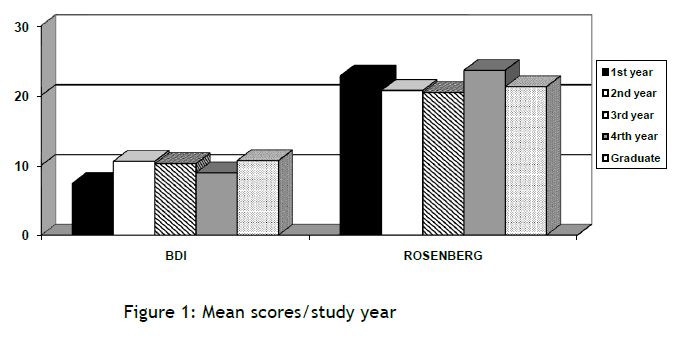
Figure 1: Mean scores/study year
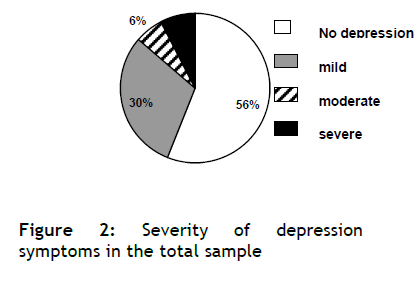
Figure 2: Severity of depression symptoms in the total sample
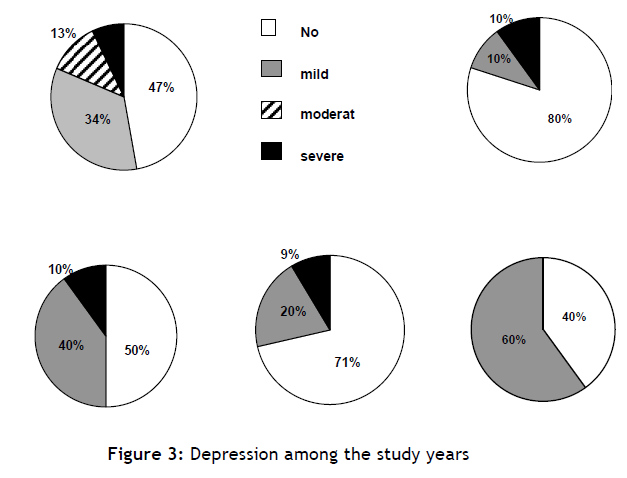
Figure 3: Depression among the study years
Results
Study Population
142 students, males (18,3%) and females (81,7%), participated in the study (response rate 100%). The mean age was 20 years (maximum age: 26, minimum age: 18). The mean score of the questionnaires in each year is presented in Figure 1.
Suicidal ideation
When questioned about thoughts or upset to killing themselves, 88% of our total sample answered that they didn’t think so 10,6 % said that they had thought of it but they would never carry these thoughts at, while 2 students (1,4%) declared that they could have done it if they had the chance (Figure 4). In figure 5, the sex suicidal ideation is presented. There were statistically significant sex differences concerning the thought of suicide, without actually carrying it out (males>females). The evaluation of suicidal ideation per year of studies indicated that the percentage of students who thought of suicide but they wouldn’t commit it were mainly in the first or in the last (graduates) years of study. (Figure 6)
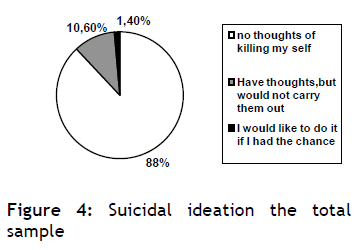
Figure 4: Suicidal ideation the total sample
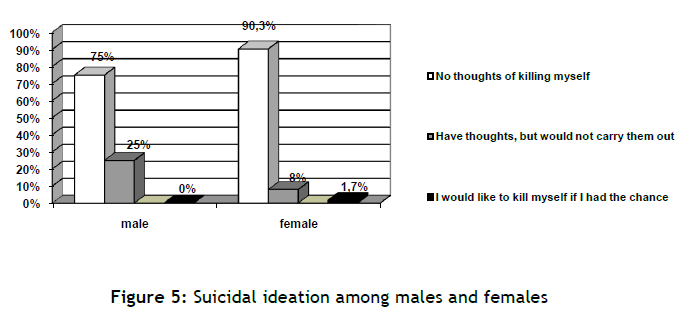
Figure 5: Suicidal ideation among males and females
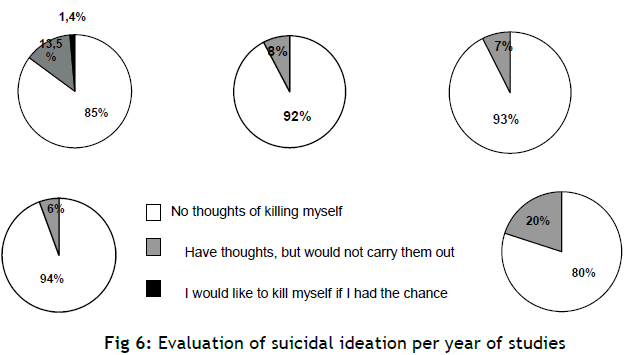
Figure 6: Evaluation of suicidal ideation per year of studies
Correlations between suicidal ideation and depression
The examination of the correlation between the total score of the scale of depression and the suicidal tendency (thoughts or desire to commit suicide, question 9 of the scale) suggested that the relation between depression and suicidal tendency is statistically significant considering that Spearman correlation co-efficiency was 0,441, indicating a directly proportional relation between depression and suicidal tendency.
Discussion
The stressors in the health professions and especially in the education of nurses and doctors have been consistently acknowledged in the literature for more than 50 years [9,10] . Τhe usual academic sources of stress include examinations, long study hours, assignments and grades, lack of free time and faculty response to student need [11] . Clinical sources of stress include working with dying patients, interpersonal conflict with other nurses, insecurity about personal clinical competence, fear of failure, work overload and concerns about nursing care given to patients [12-15] . Psychological distress, poor adjustment and coping can result in poor academic performance. In a minority of students this can result in significant psychiatric morbidity and even in suicide.
In the present study, 43% of students suffered from depression, even though only a small percentage of them had a severe form of it. The majority had mild and a few reported moderate depressive symptoms. In our sample, the lowest level of depression was found in students who were in their second study year. No significant differences were found between sexes. It can be assumed that second year students are more adjusted to the demands of their studies and more accepting of their decision to continue in this field. However, in another Greek study, freshmen exhibited the lowest depression scores and year 2 and 3 nursing students indicated experiencing the highest degree of pressure from studies resulting in a positive association between being a university senior and depressive symptoms [16] . Similar results were reported in two other studies demonstrating that freshmen had the lowest average BDI scores [17,18] . On the other hand, several studies did not find any association between BDI scores and the study year [19,20] and in another study, first year students showed more symptoms of psychological distress and depression than the others [21] . However, in our study, the increased percentage of first year students ‘who thought of suicide but they wouldn’t commit it’ is in accordance with the increased depressive symptomatology found in this study year and confirms the statistically significant positive correlation between suicidal ideation and depression.
In our research, seniors/graduates reported mild and moderate depression and increased suicidal ideation (thought of suicide but they wouldn’t commit it). It is possible that they face higher levels of stress and workload, as they have begun their clinical practice, which is accompanied with fear of making any fatal mistakes. Also, depressive symptoms may be more common as a result of student worries about their future as they are approaching graduation. Additionally a perceived lack of practical skills is a common worry for many diploma students.
The results of the present study are not conclusive regarding the suicidality of the students due to the limitation imposed by the relative small sample size. However, the strong positive correlation between depression and suicidal tendency increases the validity of our findings.
Conclusion
The above results urge mental health professionals to better understand the difficulties of nursing students. It cannot be expected that nursing faculty should be evaluating every student for depression or suicidal risk. If a faculty member suspects or registers concern for a student, a meeting to assess the situation, followed by a referral for evaluation and treatment, would be the expected protocol. Crisis intervention protocols should also be considered for implementation in nursing programs before a crisis (such as a nursing student suicide) occurs. Furthermore, counselling can help nursing students cope with academic stress, fears about their future, personal problems etc and adjust better to the demands of the nursing program and practice. Their professors could also encourage them to broaden their social networks and personal interests during their educational experience and through-out their lifetime.
3427
References
- American Association of Suicidology (2004). Youth suicide fact sheet Retrieved December, 15, 2009 from https://www.suicidology.org/c/document_library/get_file?folderId=232&name=DLFE-24.pdf
- Goetz CS. Are you prepared to S.A.V.E. your nursing student from suicide? J Nurs Educ. 1998;2:92-95
- Biggers T, Zimmerman RS, Alpert G. Nursing, nursing education and anxiety. J Nurs Educ 1988; 27(9): 411?417
- Firth JA. Levels and sources of stress in medical students. Br Med J 1986;292: 1177?1180.
- Heaman D. The Quieting Response (QR): a modality for reduction of psychophysiologic stress in nursing students. J Nurs Educ 1995;34(1): 5?10.
- Phillips NP. Reducing nursing students? anxiety levels and increasing retention of materials. J Nurs Educ 1988;27(1): 35?41.
- Russler MF. Multidimensional stress management in nursing education. J Nurs Educ 1991;30(8):341?346.
- Beck AT, Steer RA, Brow GK. BDI-II. Beck Depression Inventory manual. 1996;2nd edn., Psychological Corporation, San Antonio, USA.
- Mc Key S. A review of student stress in nursingeducation programs. Nurs Forum 1978;17:376-393
- Warbah L, Sathiyaseelan M, Vijayakumar C, Vasantharaj B, Russell S, Jacob K. Psychological distress, personality, and adjustment among nursing students. Nurs Educ, 2007;27:597-601
- Beck CT. Burnout in undergraduate nursing students. Nurs Educ 1995;20:19-23.
- Beck DL, Srivastava R. Perceived level and sources of stress in Baccalaureate nursing students. J Nurs Educ 1991;30(3):127?133.
- Parkes KR. Occupational stress among student nurses: a natural experiment. J App Psychol 1982;67(6): 784?796.
- Parkes KR. Locus of control, cognitive appraisal, and coping in stressful episodes. J Pers Soc Psychol 1984;46(3): 655?668.
- Parkes KR. Stressful episodes reported by first year student nurses: a descriptive account. Soc Sci Med 1985;20(9):945?953.
- Papazisis G, Tsiga E, Papanikolaou N, Vlasiadis 1, Sapountri Krepia D. Psychological distress, anexiety and depression among nursing students in Greece. Int J Car Sci, 2008;11(1): 42-46
- Bakir B, Yilmaz R, Yavas I, Toraman R, Gulec N. The problems in undergraduate medical students and compared to depressive symptoms with sociodemographic characteristics. J Psych Neurol Sci 1997;10:5-12.
- Bostanci M., Ozdel O, Oguzhanoglu N, Ozdel L, Ergin A, Ergin N, et al. Depressive Symptomatology among University Students in Denizli, Turkey: Prevalence and Sociodemographic Correlates. Croat Med J 2005;46(1):96-100.
- Dogan O, Dogan S, Corapcioglu A, Celik G. The prevalence of depression in university students and its relation with some variables. J Cum Uni Med Fac 1994;16:148-51.
- Taysi BN, Azizoglu F, Percinel S, Hasan SH. The evaluation of depression prevalence with Beck Depression Inventory among the intern doctors during to 1992-1993 academic period. Society and Physician 1994;59:68-74.
- Jones M, Johnston D. Distress, stress and coping in first-year student nurses. J Adv Nurs 1997;26:475?482.











